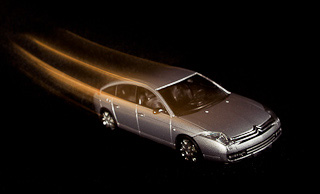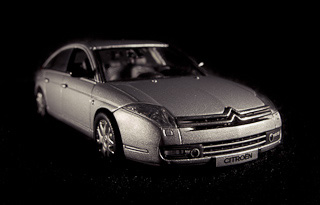Cactus RF60 Review
Special Features
Despite not being a digital TTL flash, the RF60 offers some semi-automatic versions of features that are normally only found on very expensive dedicated flash models.
Second-Curtain Sync
 |
| Second-Curtain Sync With regular first-curtain sync, the motion trails would precede the car. |
Second-curtain sync – also known as “Rear-curtain sync”, or “Trailing Curtain Sync” – is useful when combining ambient light and flash light in one exposure if objects in motion are involved. The image to the right shows an example where the camera first recorded the motion trails and then, in a final step, fired the flash that illuminated the whole subject, freezing its motion with its small duration.
Without second-curtain sync, the car in the image above would have appeared to the left of the motion trails. The car would have been illuminated by the flash before the motion trails had any time to develop. In other words, regular first-curtain sync results in highly unnatural images whenever motion, slow shutter speeds, and flash light are involved.
Second-curtain sync requires the camera to trigger the flash just before the end of the exposure. Unfortunately, Pentax’s solution to second-curtain sync normally requires rather expensive P-TTL capable flashes.
Luckily, the RF60 offers two alternative ways of achieving second-curtain sync:
- The RF60 can piggy-back on to an existing P-TTL flash set to “Trailing Curtain Sync” by triggering on the latter’s main flash. If one sets the RF60’s optical triggering method to “S2 – Main Flash”, the RF60 will ignore the P-TTL pre-flash and will contribute to the exposure during the delayed, second-curtain synchronised main flash.
- The RF60 allows to specify a triggering delay. By setting this delay to approximately the shutter speed, one can delay the RF60’s exposure contribution so that it becomes equivalent to a P-TTL flash configured to “Trailing Curtain Sync”.
Obviously, the second method requires a bit of experimentation to obtain the correct delay value for a given shutter speed, and values will have to be adapted when shutter speeds are changed. On the plus side, this semi-automatic approach means that one can obtain the effect of second-curtain sync with K- or M- lenses as well (not just A- lenses or better, as required by P-TTL).
No doubt, photographers will find many other creative uses for the triggering delay feature of the RF60, such as creating interesting multi-exposure series using multiple flashes with different delays.
High-Speed Sync
High-Speed Sync is required whenever shutter speeds beyond the camera’s so-called sync speed are used. Such shutter speeds are achieved by letting the second curtain close before the first curtain has fully opened. As a result, there is no longer a moment in which all of the sensor can be illuminated by a single, short flash.
High-Speed Sync, also known as “HSS”, hence involves prolonging the flash illumination so that it lasts as long as the shutter slit (formed by the first and second curtains) needs to travel over the sensor. The RF60 can produce such prolongued flash pulses in a special “HSS” mode that can be activated by two button presses.
 |
| High-Speed Sync With one HSS-capable flash, one can trigger multiple RF60 at any shutter speed (here at 1/1500s). |
On a Nikon camera, for instance, activating the RF60’s “HSS” mode is all that is required. Unfortunately, Pentax DSLRs disable all forms of triggering once the shutter speed exceeds 1/180s. The only way to obtain a flash trigger event for shutter speeds beyond 1/180s is to use an HSS-capable flash connected to the camera. The pre-flash from this flash can then be used to optically trigger one or more RF60. Conveniently, the RF60 automatically engages optical triggering when one enters HSS mode, so all that is left for the user to do is to figure out and enter the correct delay required between pre-flash and the actual exposure so that the HSS pulse can optimally contribute to the exposure.
The correct delay unfortunately depends a bit on the chosen aperture since closing down to smaller aperture takes a little bit longer than leaving the aperture more open. Sometimes, it may be feasible to simply switch to “S2 – Main flash” triggering and choose zero delay, making the use of HSS mode much more convenient. Whether or not this is possible depends on whether one will experience or can tolerate a band at the bottom of the frame that will not be illuminated by the flash.
Flash output levels change in HSS mode compared to the regular levels and are less predictable than they ideally should be. In combination with the need to figure out the correct delay for optimal use, this semi-automatic HSS mode requires quite a bit of dedication from the photographer to get results. On the other hand, finally there is an HSS option, i.e., a means to break the 1/180s barrier with multiple flashes without breaking the bank as well.
The HSS image featured above was taken with a shutter speed of 1/1500s with two RF60 contributing. Even exposures at 1/8000s are possible but note that an HSS pulse is essentially like continuous light and hence is effectively diminished in power by increasing shutter speeds. The use of multiple flash units can counteract this phenomenon.
N.B., there is one alternative to the above use of an HSS-capable flash to enable HSS off-camera flash use: It relies on triggering both camera and off-camera flashes simultaneously.
Multi-Mode
 |
| Multi-mode Stroboscopic effects are an alternative to motion blur in order to depict motion. |
The ability to create stroboscopic exposures, i.e., multiple exposures of a moving subject in one single frame, is available in all modes.
The image to the right is borrowed from my Cactus LV5 review and shows how one trigger event can create a multitude of exposures. I had set the camera to bulb mode for this image and controlled the exposure time manually. Alternatively, one can work out the shutter speed required to capture a certain amount of flashes that occur at a certain frequency. The RF60 manual discusses this approach and provides a formula.



